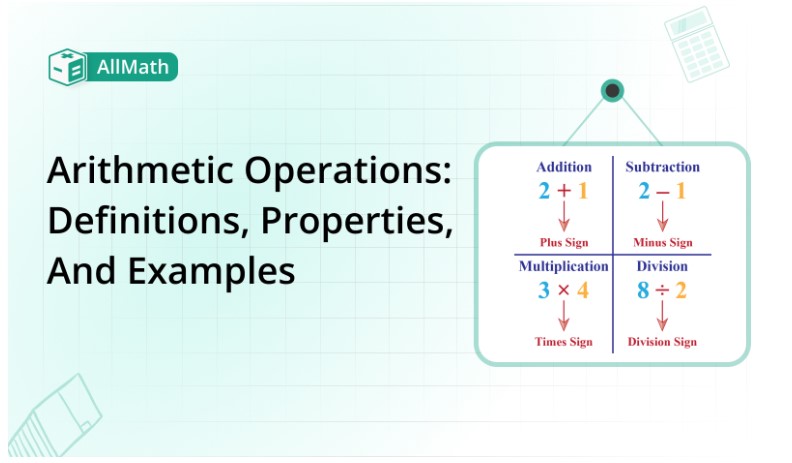To calculate result you have to disable your ad blocker first.
Arithmetic Operations: Definitions, Properties, and Examples

Publish Date: 08 Aug, 2023
Table of Content
Arithmetic is the foundation of mathematics, which is necessary for every feature of daily life. It includes working with numbers to find solutions to problems that come up in a variety of corrections, like science, engineering, and finance. To gain a deeper comprehension of mathematics an understanding of arithmetic operations is necessary.
The fundamentals of addition, subtraction, multiplication, and division will be explained in this article. We will also explain the properties, and rules, to aid your understanding.
Basic Arithmetic Operations
In Math, there are four basic arithmetic operations,
- Addition (+)
- Subtraction (-)
- Multiplication
- Division (÷)
Here, we’ll explain all the basic arithmetic operations.
Definition of Addition
Adding items together mathematically is the process of addition. it is represented by the (+). In addition, is important to align the numbers according to their places.
Rules of Addition
- The outcome is positive when two positive numbers are added.
- The outcome is negative when you add two negative numbers.
- When we add positive and negative numbers, we use the sign of the largest number in the result.
Properties of Addition
- Commutative property: when we add two numbers in any order and the result doesn’t affect is called commutative property. For instance, 3 + 2 and 2 + 3 are equivalent.
- Associative property: This property says that the sum is unaffected by how the numbers are grouped before being added. For instance, 6 + (3 + 8) is equivalent to 6 + 3 + 8.
- Identity property: According to identity property, the result is the same by adding zero to any number. For instance, 9 + 0 is equivalent to 9
- Inverse property: According to this property every number has its inverse and its sum is equal to zero
For example, 8 has inverse -8 and their sum will be equal to zero.
Examples
3 + 4 = 7
3 + (-2) = 1
Definition of Subtraction
Subtraction is defined as the arithmetic operation that is used to calculate the difference between two integers. It is indicated by the "-".
Rules of Subtraction
- When the sign of two integers is negative the result will be negative.
- When we subtract positive and negative numbers, we use the sign of the largest number in the result.
Properties of Subtraction
- Subtraction as the inverse of addition: This implies that we can add the reverse of a number to remove it. For instance, 5 - 3 is equivalent to 5 + (-3).
- Subtraction with zero: This implies that the result will be the same if we subtract zero from any number. For instance, 5 – 0 is equivalent to 5
Examples
3 - 4 = -1
3 - (-2) = 5
Definition of Multiplication
Multiplication is the arithmetic operation used to calculate the sum of two or more numbers. The symbol "×" is used to represent it.
Rules of Multiplication
- The outcome of the multiplication of two positive integers is positive.
- The outcome of the multiplication of two negative integers is positive.
- A negative number is produced by multiplying negative and positive integers.
Properties of Multiplication
- Commutative property: when we multiply two numbers in any order and the result doesn’t affect is called commutative property. For instance, 2 × 3 is equivalent to 3 × 2
- Associative property: This property says that multiplication is unaffected by how the numbers are grouped before being multiplied. For instance, 6 × (3 × 8) is equivalent to (6 × 3) × 8
- Identity property: The identity property states that the outcome is unchanged when 1 is multiplied by any integer. As an illustration, 9 1 equals 9.
- Zero property: This property implies any number multiplied by zero is zero. For example, 10 × 0 is 0.
Examples
3 x 4 = 12
3 x (-2) = -6
Definition of Division
Splitting a quantity or number into equal parts or groups is the mathematical process known as division. It is the opposite of multiplication. We denoted the division by this symbol “÷”
Rules for Division
- The outcome is positive when two positive numbers are divided.
- The outcome is positive when two negative numbers are divided.
- The outcome is negative when two different sign numbers are divided.
Properties of Division
- Division as the inverse of multiplication: This property implies that division is the inverse of multiplication. For example, 8 ÷ 4 is equivalent to 8 × (1 / 4)
- Division by one: This property implies that dividing any number by one gives us the same number. For example, 10 ÷ 1 is equivalent to 10.
- Division by zero: This property implies that if we divide any number by zero the result is undefined.
Examples
12 / 4 = 3
3 / 3 = 1
Order of Operations
It is necessary to maintain the sequence of operations while executing multi-step arithmetic operations. The order of operations is a collection of guidelines that establishes the sequence in which tasks are completed. PEMDAS is another name for the operating technique. The following is the sequence of order operations.

Conclusion
In this article, we learned that arithmetic operation is one of the basic concepts of mathematics.it is used to find solutions to those problems that come up in engineering, science, and finance. we can solve numerical problems easily by understanding basic arithmetic operations of addition, subtraction, multiplication, and division along with their rules and properties.

